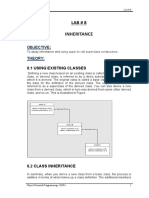Java LAB 8
Uploaded by
Ramsha MaharJava LAB 8
Uploaded by
Ramsha MaharInheritance Lab # 8
LAB # 8
INHERITANCE
OBJECTIVE:
To study inheritance and using super to call superclass constructors.
THEORY:
8.1 USING EXISTING CLASSES
Defining a new class based on an existing class is called derivation. The new
class, or derived class, is referred to as a direct subclass of the class from
which it is derived. The original class is called a base class because it forms
the base for the definition of the derived class. The original class is also
referred to as a superclass of the derived class. You can also derive a new
class from a derived class, which in turn was derived from some other derived
class, and so on. This is illustrated in Figure.
8.2 CLASS INHERITANCE
In summary, when you derive a new class from a base class, the process is
additive in terms of what makes up a class definition. The additional members
Object Oriented Programming - OOPs 1
Inheritance Lab # 8
that you define in the new class establish what makes a derived class object
different from a base class object. Any members that you define in the new
class are in addition to those that are already members of the base class.
The inclusion of members of a base class in a derived class so that they are
accessible in that derived class is called class inheritance. An inherited
member of a base class is one that is accessible within the derived class. If a
base class member is not accessible in a derived class, then it is not an
inherited member of the derived class, but base class members that are not
inherited still form part of a derived class object.
Inheriting Data Members:
Figure shows which access attributes permit a class member to be inherited
in a subclass. It shows what happens when the subclass is defined in either
the same package or a different package from that containing the base class.
Remember that inheritance implies accessibility of the member in a derived
class, not just presence.
Inheritance Basics:
To inherit a class, you simply incorporate the definition of one class into
another by using the extends keyword. To see how, let’s begin with a short
example. The following program creates a superclass called A and a subclass
called B. Notice how the keyword extends is used to create a subclass of A.
// A simple example of inheritance.
// Create a superclass.
class A
{
int i, j;
void showij()
{
System.out.println("i and j: " + i + " " + j);
}
}
Object Oriented Programming - OOPs 2
Inheritance Lab # 8
// Create a subclass by extending class A.
class B extends A
{
int k;
void showk()
{
System.out.println("k: " + k);
}
void sum()
{
System.out.println("i+j+k: " + (i+j+k));
}
}
class SimpleInheritance
{
public static void main(String args[])
{
A superOb = new A();
B subOb = new B();
// The superclass may be used by itself.
superOb.i = 10;
superOb.j = 20;
System.out.println("Contents of superOb: ");
superOb.showij();
System.out.println();
/* The subclass has access to all public members of
its superclass. */
subOb.i = 7;
subOb.j = 8;
subOb.k = 9;
System.out.println("Contents of subOb: ");
subOb.showij();
subOb.showk();
System.out.println();
System.out.println("Sum of i, j and k in subOb:");
subOb.sum();
}
}
Output:
Object Oriented Programming - OOPs 3
Inheritance Lab # 8
8.3 CALLING THE BASE CLASS CONSTRUCTOR
Using super:
super has two general forms. The first calls the superclass’ constructor. The
second is used to access a member of the superclass that has been hidden
by a member of a subclass.
Using super to Call Superclass Constructors
A subclass can call a constructor method defined by its superclass by use of
the following form of super:
super(parameter-list);
Here, parameter-list specifies any parameters needed by the constructor in
the superclass. super( ) must always be the first statement executed inside a
subclass’ constructor.
class Box {
private double width;
private double height;
private double depth;
// construct clone of an object
Box(Box ob) { // pass object to constructor
width = ob.width;
height = ob.height;
depth = ob.depth;
}
// constructor used when all dimensions specified
Box(double w, double h, double d) {
width = w;
height = h;
depth = d;
}
// compute and return volume
Object Oriented Programming - OOPs 4
Inheritance Lab # 8
double volume() {
return width * height * depth;
}
}
// BoxWeight now fully implements all constructors.
class BoxWeight extends Box {
double weight; // weight of box
// construct clone of an object
BoxWeight(BoxWeight ob) { // pass object to constructor
super(ob);
weight = ob.weight;
}
// constructor when all parameters are specified
BoxWeight(double w, double h, double d, double m) {
super(w, h, d); // call superclass constructor
weight = m;
}
}
class DemoSuper {
public static void main(String args[]) {
BoxWeight mybox1 = new BoxWeight(10, 20, 15, 34.3);
BoxWeight myclone = new BoxWeight(mybox1);
double vol;
vol = mybox1.volume();
System.out.println("Volume of mybox1 is " + vol);
System.out.println("Weight of mybox1 is " + mybox1.weight);
System.out.println();
vol = myclone.volume();
System.out.println("Volume of myclone is " + vol);
System.out.println("Weight of myclone is " + myclone.weight);
System.out.println();
}
}
Output:
Object Oriented Programming - OOPs 5
Inheritance Lab # 8
LAB TASK
1. Develop a registration system for a University. It should consist of
three classes namely Student, Teacher, and Course. For example, a
student needs to have a name, roll number, address and GPA to be
eligible for registration. Therefore choose appropriate data types for
encapsulating these properties in a Student objects. Similarly a
teacher needs to have name, address, telephone number, and a
degree (or a list of degrees) he/she has received. Finally courses must
have a name, students (5 students) registered for the course, and a
teacher assigned to conduct the course. Create an object of Course
with 5 Students and a Teacher. A call to a method, say printDetails(), of
the selected course reference should print name of the course, details
of the teacher assigned to that course, and names and roll numbers of
the students enrolled with the course.
2. Create a class called computers and two classes MyComputer and
YourComputer which inherits computer class. Define appropriate
features of their processor in the classes. Create another class
processor as a composite class of computer. Write a method which
prints the differences between the processors of two computers.
Example:
single core:
bandwidth = 125GByte/s
speed = slow
processing = sequentially
Object Oriented Programming - OOPs 6
You might also like
- Grade-5-Adding-Fractions-Mixed-Numbers-Unlike A-ENo ratings yetGrade-5-Adding-Fractions-Mixed-Numbers-Unlike A-E6 pages
- Why Use Inheritance in Java: Class: Sub Class/Child Class: Super Class/Parent Class: ReusabilityNo ratings yetWhy Use Inheritance in Java: Class: Sub Class/Child Class: Super Class/Parent Class: Reusability11 pages
- Inheritance, Package, Interface and Exception Handling 3.1 InheritanceNo ratings yetInheritance, Package, Interface and Exception Handling 3.1 Inheritance7 pages
- Q1: What Is Inheritance? Discuss Its TypesNo ratings yetQ1: What Is Inheritance? Discuss Its Types15 pages
- Window Programming Ch3 C# OO Concepts ModifiedNo ratings yetWindow Programming Ch3 C# OO Concepts Modified12 pages
- IGNOU PGDCA MCS 206 Object Oriented Programming using Java Previous Years solved PapersFrom EverandIGNOU PGDCA MCS 206 Object Oriented Programming using Java Previous Years solved PapersNo ratings yet
- Object Oriented Programming Inheritance: Fundamentals and ApplicationsFrom EverandObject Oriented Programming Inheritance: Fundamentals and ApplicationsNo ratings yet
- Sir Syed University of Engineering & Technology: Answer ScriptNo ratings yetSir Syed University of Engineering & Technology: Answer Script12 pages
- Object Oriented Programming (Swe-103) Lab Exam: Stock Symbol Name Double Previousclosingprice Double CurrentpriceNo ratings yetObject Oriented Programming (Swe-103) Lab Exam: Stock Symbol Name Double Previousclosingprice Double Currentprice3 pages
- Object Oriented Programming: Roll number:-SE20-190No ratings yetObject Oriented Programming: Roll number:-SE20-19010 pages
- Sir Syed University of Engineering & Technology: Answer ScriptNo ratings yetSir Syed University of Engineering & Technology: Answer Script18 pages
- Sir Syed University of Engineering & Technology: Answer ScriptNo ratings yetSir Syed University of Engineering & Technology: Answer Script16 pages
- The Strategies in The Battles and Struggles of Prophet Muhammad: How It Can Be Applied in Modern BusinessNo ratings yetThe Strategies in The Battles and Struggles of Prophet Muhammad: How It Can Be Applied in Modern Business27 pages
- Sir Syed University of Engineering & Technology: Answer ScriptNo ratings yetSir Syed University of Engineering & Technology: Answer Script18 pages
- 2 3 + 4 0 ( + 1) 5, ( + 1) 3 Where A Is The Last Digit of Your Roll NumberNo ratings yet2 3 + 4 0 ( + 1) 5, ( + 1) 3 Where A Is The Last Digit of Your Roll Number1 page
- Name:-Seemal Irfan Department: - Software Engineering Batch: - 2020No ratings yetName:-Seemal Irfan Department: - Software Engineering Batch: - 20205 pages
- Uniform Fiber Bragg Grating Modeling and Simulation Used Matrix Transfer MethodNo ratings yetUniform Fiber Bragg Grating Modeling and Simulation Used Matrix Transfer Method7 pages
- Apache CloudStack 4.0.0 Incubating API Developers Guide en USNo ratings yetApache CloudStack 4.0.0 Incubating API Developers Guide en US44 pages
- Third Semester B.E. (CBCS) Examination Engineering Mathematics-IIINo ratings yetThird Semester B.E. (CBCS) Examination Engineering Mathematics-III3 pages
- Six Axis Articlated Robotic Arm 2nd PresentationNo ratings yetSix Axis Articlated Robotic Arm 2nd Presentation17 pages
- Voltage and Frequency Regulation of Microgrid With Battery Energy Storage SystemsNo ratings yetVoltage and Frequency Regulation of Microgrid With Battery Energy Storage Systems11 pages
- Snowflake SnowPro Core Certification Exam Questions - Page 24 of 27 - SkillCertProNo ratings yetSnowflake SnowPro Core Certification Exam Questions - Page 24 of 27 - SkillCertPro1 page
- Transformers, How Do They Work?: Generative AI To Create ContentNo ratings yetTransformers, How Do They Work?: Generative AI To Create Content14 pages
- Perhitungan Data Teknis Pompa Hidrolis, Motor Hidrolis Dan Prime Mover (Engine Diesel)No ratings yetPerhitungan Data Teknis Pompa Hidrolis, Motor Hidrolis Dan Prime Mover (Engine Diesel)2 pages
- GL200 SMS Protocol V102 Decrypted.100130920 PDFNo ratings yetGL200 SMS Protocol V102 Decrypted.100130920 PDF28 pages
- Part and Assembly Modeling: With Solidworks 2014100% (1)Part and Assembly Modeling: With Solidworks 2014123 pages
- Why Use Inheritance in Java: Class: Sub Class/Child Class: Super Class/Parent Class: ReusabilityWhy Use Inheritance in Java: Class: Sub Class/Child Class: Super Class/Parent Class: Reusability
- Inheritance, Package, Interface and Exception Handling 3.1 InheritanceInheritance, Package, Interface and Exception Handling 3.1 Inheritance
- IGNOU PGDCA MCS 206 Object Oriented Programming using Java Previous Years solved PapersFrom EverandIGNOU PGDCA MCS 206 Object Oriented Programming using Java Previous Years solved Papers
- Object Oriented Programming Inheritance: Fundamentals and ApplicationsFrom EverandObject Oriented Programming Inheritance: Fundamentals and Applications
- Sir Syed University of Engineering & Technology: Answer ScriptSir Syed University of Engineering & Technology: Answer Script
- Object Oriented Programming (Swe-103) Lab Exam: Stock Symbol Name Double Previousclosingprice Double CurrentpriceObject Oriented Programming (Swe-103) Lab Exam: Stock Symbol Name Double Previousclosingprice Double Currentprice
- Object Oriented Programming: Roll number:-SE20-190Object Oriented Programming: Roll number:-SE20-190
- Sir Syed University of Engineering & Technology: Answer ScriptSir Syed University of Engineering & Technology: Answer Script
- Sir Syed University of Engineering & Technology: Answer ScriptSir Syed University of Engineering & Technology: Answer Script
- The Strategies in The Battles and Struggles of Prophet Muhammad: How It Can Be Applied in Modern BusinessThe Strategies in The Battles and Struggles of Prophet Muhammad: How It Can Be Applied in Modern Business
- Sir Syed University of Engineering & Technology: Answer ScriptSir Syed University of Engineering & Technology: Answer Script
- 2 3 + 4 0 ( + 1) 5, ( + 1) 3 Where A Is The Last Digit of Your Roll Number2 3 + 4 0 ( + 1) 5, ( + 1) 3 Where A Is The Last Digit of Your Roll Number
- Name:-Seemal Irfan Department: - Software Engineering Batch: - 2020Name:-Seemal Irfan Department: - Software Engineering Batch: - 2020
- Uniform Fiber Bragg Grating Modeling and Simulation Used Matrix Transfer MethodUniform Fiber Bragg Grating Modeling and Simulation Used Matrix Transfer Method
- Apache CloudStack 4.0.0 Incubating API Developers Guide en USApache CloudStack 4.0.0 Incubating API Developers Guide en US
- Third Semester B.E. (CBCS) Examination Engineering Mathematics-IIIThird Semester B.E. (CBCS) Examination Engineering Mathematics-III
- Voltage and Frequency Regulation of Microgrid With Battery Energy Storage SystemsVoltage and Frequency Regulation of Microgrid With Battery Energy Storage Systems
- Snowflake SnowPro Core Certification Exam Questions - Page 24 of 27 - SkillCertProSnowflake SnowPro Core Certification Exam Questions - Page 24 of 27 - SkillCertPro
- Transformers, How Do They Work?: Generative AI To Create ContentTransformers, How Do They Work?: Generative AI To Create Content
- Perhitungan Data Teknis Pompa Hidrolis, Motor Hidrolis Dan Prime Mover (Engine Diesel)Perhitungan Data Teknis Pompa Hidrolis, Motor Hidrolis Dan Prime Mover (Engine Diesel)



































































































